Understanding Carpenter Ant Colonies: Behavior & Management
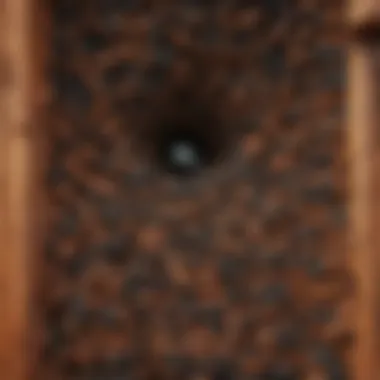
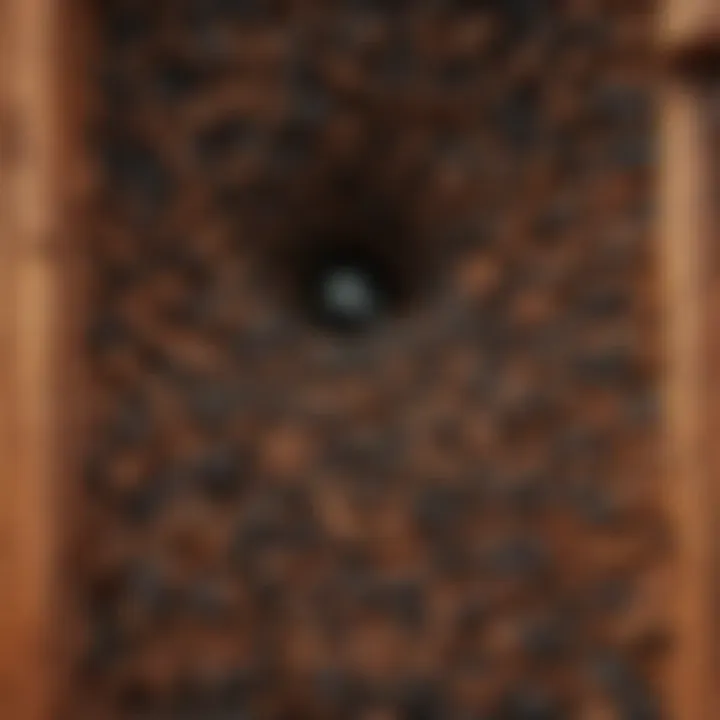
Intro
Carpenter ants are often overlooked until they cause significant damage to wooden structures. Understanding the intricacies of their colonies is essential for homeowners and pest control professionals alike. This article aims to explore the anatomy, behavior, and management strategies related to carpenter ant colonies, providing a thorough understanding of these pests and the implications of their presence in our environment.
Pest Identification
Detailed Descriptions of Common Pests
Carpenter ants can be easily confused with other ant species. These insects vary in size, typically ranging from 1/4 to 1/2 inch in length. Carpenter ants are usually black, but can also be red or bicolored. Their mandibles are well-developed, suitable for excavating wood. Unlike termites, carpenter ants do not consume wood; rather, they tunnel through it to create nesting galleries.
Signs and Symptoms of Infestations
Identifying an infestation early can save homeowners significant repair costs. Some common signs include:
- Frass: This is a sawdust-like material that consists of wood shavings and debris, expelled from their nests.
- Rustling Noises: During active hours, the sound of movement can be noticed within wooden structures.
- Visible Tunnels: If visible, these appear as smooth, rounded galleries in wood.
Early identification is key to effective pest management. Signs of carpenter ant activity should not be ignored.
Prevention Strategies
Home Maintenance Tips for Pest Prevention
Preventing carpenter ants from infesting properties is often more effective than treating existing problems. Consider these strategies:
- Seal Cracks: Ensure that holes in walls, around windows, and doors are sealed.
- Proper Drainage: Make sure that water does not collect near the foundation of the house.
- Wood Inspection: Regularly check for damp or rotting wood in structures, as these are attractive to carpenter ants.
Natural Deterrents and Barriers
Natural deterrents can also help to keep carpenter ants at bay. Some useful measures include:
- Vinegar Solution: A mixture of vinegar and water can disrupt pheromone trails left by ants, making it hard for them to navigate.
- Essential Oils: Scents like peppermint or tea tree oil can repel ants. Simply mix with water and spray areas prone to infestation.
Treatment Options
Overview of Chemical vs. Natural Treatments
When it comes to treatment, homeowners have options. Chemical treatments involve insecticides that may provide immediate relief but can have health implications and environmental concerns. Natural treatments, on the other hand, offer safer alternatives but often require more persistence to achieve results.
Step-by-Step Guides for DIY Treatments
For anyone considering a DIY approach:
- Identify the Nest Location: Finding where the ants are nesting is crucial.
- Choose Your Treatment: Decide whether to use a chemical or natural method.
- Apply the Treatment: Follow the product guidelines carefully or apply your natural solutions regularly.
- Monitor Activity: Keep an eye out for any further signs of infestation after treatment.
By understanding carpenter ant colonies, their behavior, and effective management strategies, homeowners can address potential threats. Timely intervention can prevent costly damage and maintain the structural integrity of homes.
Intro to Carpenter Ants
Carpenter ants represent a significant concern for homeowners, particularly those living in wooden structures. Understanding the basics of these insects is critical for effective pest control and prevention measures. Many people may overlook the presence of carpenter ants until they discover severe structural damage. Early identification can save homeowners from costly repairs. Therefore, knowing how to identify these insects and recognizing their habitats is essential.
Defining Carpenter Ants
Carpenter ants are large black or bicolored insects known for their wood-destroying habits. Typically, they measure between 1/4 to 1 inch in length. Their bodies are smooth and shiny, contrasting with termites, who possess a more robust appearance with less refined body segments.
Carpenter ants build their nests inside wood, often in areas that are damp or decaying. Unlike termites, carpenter ants do not eat wood. Instead, they excavate it to create galleries for their colonies. This behavior can lead to significant structural damage over time if left untreated.
Geographic Distribution
Carpenter ants are found throughout much of North America, particularly in regions abundant in wood vegetation. They thrive in forests, suburban areas, and rural landscapes. Their distribution is influenced by climate and moisture levels, as they prefer warmer, more humid environments.
Identifying their geographic spread can help homeowners understand if they live in a high-risk area. Here are a few points about their distribution:
- Commonly found in:
- Notable Species:
- Urban areas with older buildings
- Regions with abundant trees
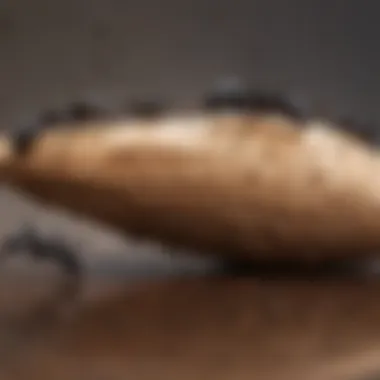
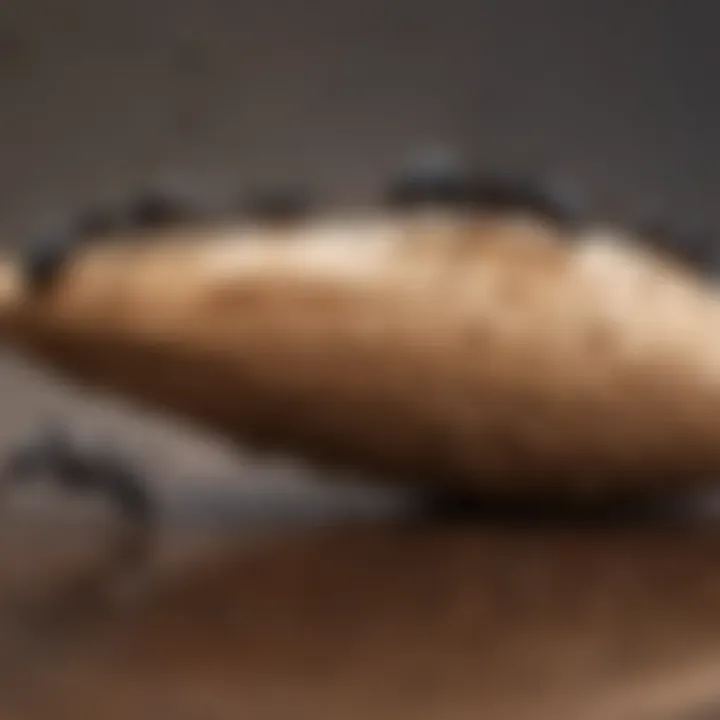
- Camponotus herculeanus (Northern Carpenter Ant)
- Camponotus vagus (Western Carpenter Ant)
Early recognition of carpenter ant presence in a home can lead to prompt intervention. Understanding their defining characteristics and geographic trends offers a foundation for effective management solutions.
Anatomy of a Carpenter Ant Colony
Understanding the anatomy of a carpenter ant colony is crucial for recognizing the overall structure and functionality of these insects. Each role within the colony contributes to its survival, reproduction, and resilience against threats. The implications for homeowners become clear when we explore how these elements shape both ant behavior and management strategies. Knowing the roles of the various types of ants within a colony can inform effective pest management techniques.
Queen's Role and Lifecycle
The queen is the cornerstone of any carpenter ant colony. Her primary function is reproduction; she can lay thousands of eggs in her lifetime. This role ensures the colony's growth and sustainability. Typically, a colony starts with a single, fertile queen who establishes a nest after mating.
The lifecycle of the queen involves several stages. After mating, she starts to lay eggs that hatch into larvae. These larvae are cared for by worker ants until they mature. Importantly, the queen can live for many years, often more than ten, which underscores her significant role in the colony's continuity.
Worker Ants: Functions and Tasks
Worker ants represent the bulk of the colony's population. Their tasks are diverse and vital for maintaining the colony's health. These ants are responsible for gathering food, caring for the queen and larvae, maintaining and expanding the nest, and defending against predators. Worker ants do not reproduce but contribute to the colony's function in many ways. This division of labor is efficient, allowing the colony to thrive under various conditions.
Efficiency is key in how these ants operate. They coordinate in foraging and nest-building activities, and they communicate through pheromones to signal the availability of food and to alert others of threats. This cooperation is essential for their survival.
Drones and Their Purpose
Drones are the male ants of the colony, primarily purposed for mating. Unlike the queen and worker ants, drones do not perform other colony functions. They are born in the summer months specifically to mate with a queen from another colony. After mating, drones typically die soon afterward. This reproductive strategy ensures genetic diversity within the colony.
In summary, the diverse roles within a carpenter ant colony demonstrate the complexity of their social structure. Recognizing the differences among the queen, worker ants, and drones allows homeowners and pest management professionals to devise better strategies for control and prevention, ultimately leading to more effective management of carpenter ant infestations.
Colony Structure and Dynamics
Understanding the colony structure and dynamics of carpenter ants is crucial for effective pest management. These ants live in highly organized communities that function smoothly, much like a well-oiled machine. The structure consists of various castes, each with distinct roles. This organization is essential for survival, reproduction, and colony growth. Recognizing the dynamics within these colonies allows homeowners to better grasp how carpenter ants operate and ultimately to mitigate their impact on structural integrity.
Organization of the Colony
The organization of a carpenter ant colony is hierarchical. At the apex is the queen, who is crucial for reproduction. She lays eggs which develop into new ants. The worker ants are the backbone of the colony, managing foraging and nest maintenance. Additionally, drones, the male ants, exist solely for reproduction. This caste system facilitates efficient operation, ensuring tasks are managed without overlap or wasted energy.
- Queen Ants: Female ants that establish new colonies and produce offspring.
- Worker Ants: All non-reproductive female ants responsible for the colony’s daily functions, including foraging, feeding, and defending.
- Drones: Males that mate with the queen and do not participate in other colony tasks.
Nest Building Behavior
Nests are a focal point in carpenter ant colonies. These structures can be found in various locations, such as inside wood, in soil, or even under stones. The choice of nesting site often depends on the availability of moisture and food sources. Carpenter ants do not consume wood like termites but dig into it to create tunnels and chambers. The excavation results in sawdust, which often becomes a tell-tale sign of an infestation. Awareness of these indicators can prompt timely intervention.
Some common nest types include:
- Type 1: Nests within decayed or damaged wood.
- Type 2: Nests constructed under or inside structures such as homes.
- Type 3: Satellite nests often formed away from the main colony. These are used by foraging workers needing temporary shelter.
Communication and Foraging Strategies
Effective communication among ants is vital for the success of the colony. Carpenter ants use pheromones to convey messages, including the locations of food, warnings of danger, and recruitment signals. Their ability to communicate enhances their foraging strategies, allowing them to exploit resources effectively.
During foraging, worker ants search for food, which primarily consists of proteins and sugar. Once they locate a food source, they return to the nest, leaving a pheromone trail to guide other workers. This method ensures successful foraging trips and sustains the colony.
"Understanding the communication strategies of carpenter ants is key to predicting their behavior and managing infestations."
In summary, the colony structure and dynamics of carpenter ants are intricate and highly organized. Knowledge about their organization, nest-building, and communication can be invaluable for effective pest management strategies. Recognizing these elements equips homeowners to tackle any potential issues proactively.
Reproductive Behavior and Swarming
Reproductive behavior and swarming are critical aspects of carpenter ant colonies. Understanding these elements provides insights into their population dynamics and the potential risks they pose to structures. The reproductive phase enables the continuation of the colony, while swarming is a strategy for expanding their habitat and influence.
Mating Flights
Mating flights are a fascinating and essential component of carpenter ant reproduction. Typically occurring in late spring to early summer, these flights involve both male and female ants leaving their parent colony. During these flights, virgin queens and male ants take to the air, often on warm, humid days following rain.
The primary purpose of these flights is for mating. Male ants, after mating, usually die shortly afterward. In contrast, the fertilized queens seek new nesting sites to start new colonies. The potential for extensive reproduction during mating flights can lead to rapid increases in carpenter ant populations. This growth highlights the necessity for homeowners to be vigilant, especially during swarm seasons.
Establishment of New Colonies
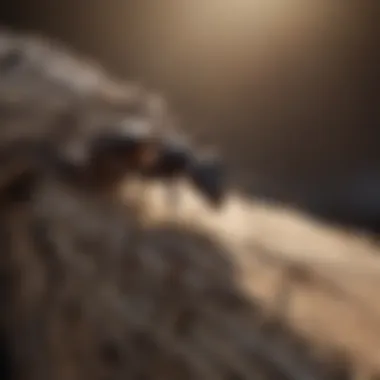

Once a queen has mated, she begins the challenging process of establishing a new colony. This involves finding a suitable location for nesting, often in decayed wood or soil. The queen will excavate a small chamber, laying eggs that will develop into worker ants. Initially, the queen raises these workers alone, functionally leading the colony until it is self-sufficient.
As the worker population grows, they take on various tasks such as foraging for food and expanding the nest. This gradual build-up allows the colony to grow steadily over time. Every aspect of establishment is crucial for long-term survival. A successful establishment can lead to severe wood damage if the colony remains undetected. Therefore, recognizing signs of a new colony early can be beneficial for maintaining structural integrity in homes.
Understanding the reproductive cycle of carpenter ants can aid in timely intervention and management strategies.
In summary, the reproductive behavior of carpenter ants and their swarming activities are crucial for sustaining their colonies. The insights gained from studying these processes allow homeowners to be proactive in their pest management efforts.
Behavioral Patterns of Carpenter Ants
Understanding the behavioral patterns of carpenter ants is crucial for effective management and control. Their social structure and interaction strategies directly influence how they establish colonies and interact within their environment. By recognizing these behaviors, homeowners can make informed decisions regarding pest management and prevention.
Territorial Defenses
Territoriality in carpenter ants is significant. These ants actively defend their foraging territory against intruders, which can include other ant species and potential threats. Typically, they will have a defined area around their nest where they patrol and scent-mark, helping to deter competitors. The workers engage in aggression towards invaders, signaling the colony's strength and adaptability.
- Ants' Aggression: When a foreign ant approaches, carpenter ants will swarm. They use their powerful mandibles to carry out defensive tasks. The presence of a strong sentry can intimidate rivals.
- Scent Marking: They deposit pheromones along their pathways. This helps in navigation and alerts other colony members of potential threats, enhancing colony unity and response times.
- Nest Defense: Carpenter ants are protective of their nests. If a nest is disturbed, they react quickly to defend their queen and brood. This act can sometimes lead to aggressive encounters with humans if they inadvertently disturb a nest.
Recognizing these territorial behaviors can aid homeowners in effectively managing infestations before they escalate.
Feeding Habits
Feeding practices of carpenter ants reflect their adaptability and resourcefulness. They are omnivorous and have a diverse diet, which supports their large colonies and complex societal structure.
- Diet Composition: Carpenter ants primarily consume proteins and sugars. They acquire sugars from honeydew, which is excreted by aphids or scale insects. This relationship is beneficial for both species, as ants protect the aphids from predators in exchange for this sugary resource.
- Foraging Behavior: Worker ants are responsible for foraging activities. They strategically scout for food options and communicate their findings back to the colony. The return of a worker ant with food often triggers a rallying response, mobilizing others to the food source.
- Storage of Food: During times of abundant food, carpenter ants may store excess food within their nests. This allows the colony to survive through periods of scarcity.
The feeding habits of carpenter ants play a critical role in their survival. Understanding what these ants consume can help homeowners in managing food sources that might attract them indoors.
Impact on Structures and Wood Damage
Carpenter ants can inflict significant damage on wooden structures, making it essential for homeowners to understand their impact and recognize the signs of an infestation. Unlike termites, which consume wood, carpenter ants excavate it to create nests. This behavior can lead to structural weakness and costly repairs. Understanding the nuances of how carpenter ants damage wood is crucial for effective management and prevention.
Identifying Damage Symptoms
Identifying damage caused by carpenter ants involves looking for specific symptoms. Here are some key indicators that may suggest an infestation:
- Frass: Carpenter ants produce sawdust-like debris as they tunnel through wood. This frass can often be found under eaves, windows, or near the entry points of nests.
- Squeaking Sounds: When carpenter ants are active, their movements can produce faint squeaking sounds within the walls of a structure. Homeowners may hear this during quiet times.
- Visual Damage to Wood: Wood may show signs of being hollowed out or have small entry holes. Fresh sawdust near these holes can signify ongoing activity.
- Trail Marks: Look for trails of ants moving consistently in one direction. This behavior often indicates where ants are foraging for food or transporting materials.
Regular inspections of these symptoms can lead to early detection of carpenter ant infestations, helping to mitigate damage before it becomes severe.
Distinction Between Carpenter Ants and Termites
Understanding the differences between carpenter ants and termites is pivotal for effective pest management.
- Diet: Carpenter ants do not feed on wood. They remove wood to create nests. Termites, however, consume wood as their primary food source.
- Appearance: Carpenter ants are typically larger, with a more defined waist and segmented bodies. Termites are generally smaller and have straight, wide bodies. Winged carpenter ants have a distinct dark coloration compared to the lighter wings of swarmers among termites.
- Tunneling Behavior: Carpenter ants create smooth tunnels in wood, leaving behind frass. Termites produce tunnels that can appear rougher and are often located in more hidden areas due to their feeding habits.
By distinguishing between these two pests, homeowners can implement the correct treatment strategies effectively, ensuring the safety and integrity of their wooden structures.
"Understanding the behavior and impact of carpenter ants is essential for maintaining the structural integrity of your home."
In sum, addressing carpenter ant infestations requires vigilance, knowledge about damage symptoms, and the ability to distinguish these insects from termites. Such understanding allows homeowners to take proactive measures for prevention and management.
Prevention and Management Strategies
Effective prevention and management strategies are crucial when dealing with carpenter ant colonies. By understanding their behavior, nesting habits, and lifecycle, homeowners can take proactive measures to avoid infestations. Unchecked, carpenter ants can cause significant damage to wooden structures, making it essential to address the issue before it escalates. This section outlines practical steps and considerations that can help in both preventing infestations and managing existing problems.
Integrated Pest Management Approaches
Integrated Pest Management (IPM) is a comprehensive approach that combines various methods to control pest populations while minimizing risks to people and the environment. The main elements of IPM for carpenter ants include:
- Inspection: Regular inspection of your property can help identify signs of carpenter ant activity such as frass, which is wood shavings that indicate nesting.
- Monitoring: Set up monitoring traps in areas where you suspect activity. This can help understand the population dynamics and movement of the ants.
- Cultural Controls: Modify conditions that are conducive to ant nesting. This involves keeping firewood away from the house, sealing cracks in walls, and moving plants away from building foundations.
- Biological Controls: Use of natural enemies or biological agents can effectively suppress ant populations, though this requires careful selection to avoid harm to non-target organisms.
Employing IPM creates a balanced method that reduces the reliance on chemical pesticides and addresses the root causes of infestations.
Identification of Entry Points
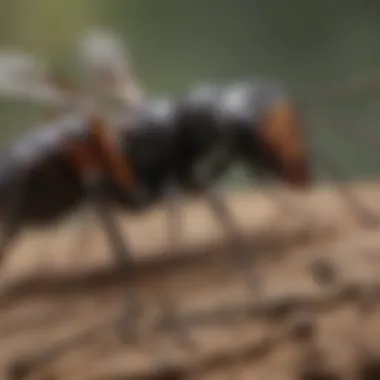
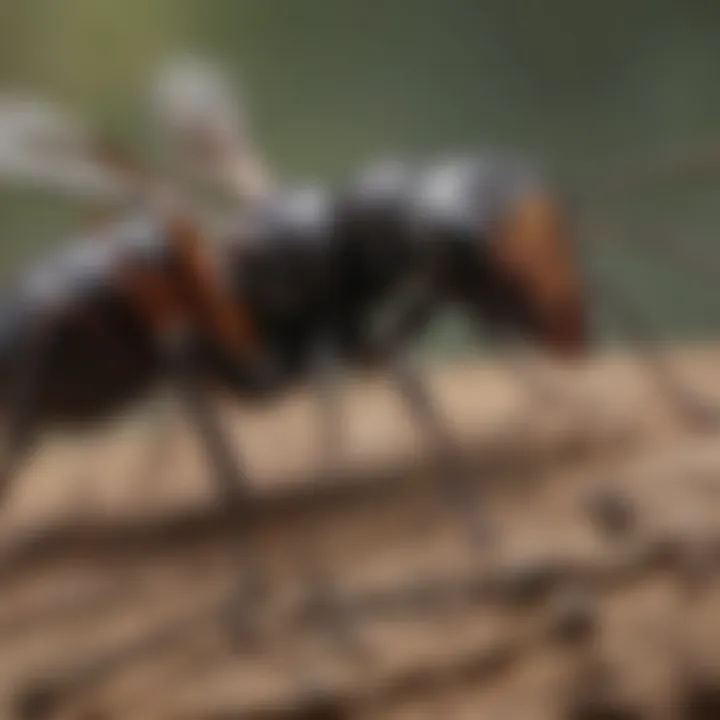
Identifying how carpenter ants enter your home is vital for effective management. Common entry points include:
- Cracks in Foundations: Small openings can be gateways for ants.
- Window and Door Frames: Poorly sealed frames can allow easy access.
- Utility Lines: Ants can travel along electrical or plumbing lines entering through gaps.
- Roof Overhangs: Areas where roofs meet the walls can be overlooked entry points.
To address these vulnerabilities, it's important to regularly check these areas and seal gaps with caulking or weather stripping. Keeping vegetation trimmed back from the house can also help prevent access.
Natural and Chemical Treatment Options
Once carpenter ants are identified and their entry points located, treatment options can be categorized into natural and chemical methods.
- Natural Treatments:
- Chemical Treatments:
- Diatomaceous Earth: This natural powder can be sprinkled in areas where ants are active. It works by damaging their exoskeletons, leading to dehydration.
- Boric Acid: When used in bait traps, it can be effective against carpenter ants without posing extreme risks to pets or humans.
- Insecticidal Sprays: These can be applied directly on the nests or trails of ants. However, caution is needed to ensure they do not contaminate food or living areas.
- Baiting Systems: Specialized bait stations can lure ants to a slow-acting poison, ensuring the entire colony is affected as the worker ants carry it back.
"Effective pest management combines thorough understanding and strategic action. Preventing infestations is always more effective than treating them after they have established."
Monitoring and Follow-up
Monitoring and follow-up are vital components in the management of carpenter ant colonies. Understanding the dynamics of these colonies goes beyond initial treatment; it requires ongoing assessment and refinement of strategies for effective control. Engaging in a structured monitoring process can significantly reduce the chances of re-infestations and ensure that any existing problems are addressed efficiently.
Establishing Monitoring Programs
Creating a robust monitoring program is fundamental for managing carpenter ant populations. This involves systematically assessing areas prone to infestations, particularly around wooden structures and landscapes. A typical monitoring program might include:
- Regular Inspections: Schedule consistent checks to identify signs of ant activity, such as frass or trails. These inspections should occur both inside and outside the home.
- Bait Stations: Implementing strategically placed bait stations can provide insights into activity levels. These help in tracking the behaviors and movements of the colony.
- Documentation: Maintain detailed logs of findings during inspections. Note locations of activity, treatment applications, and weather conditions. This information can prove invaluable for understanding patterns over time and improving future strategies.
Evaluating Success of Treatments
After treatments are applied, evaluating their success is essential to understand their effectiveness and make necessary adjustments. Here are key elements to consider:
- Monitoring Ant Activity: Keep an eye on ant movement and feeding behavior post-treatment. Is there a noticeable decrease in sightings? This is a primary indicator of treatment success.
- Assessing Structural Damage: Look for signs of ongoing damage to wood structures. If damage persists, it may indicate that the colony remains active despite treatment.
- Feedback Mechanisms: Engage homeowners in tracking perceived ant problems over time. Regular feedback can help adjust strategies and identify potential issues quickly.
“Understanding carpenter ant behavior is crucial in determining the effectiveness of management strategies.”
Myths and Misconceptions Regarding Carpenter Ants
Understanding common misconceptions about carpenter ants is crucial for effective pest management and prevention strategies. Many homeowners and housewives fall prey to myths that can lead to misinformed decisions. This section will clarify these misunderstandings. By dispelling these myths, one can foster a more accurate and informed approach to dealing with these pests, enhancing one’s ability to protect their home effectively.
Common Misbeliefs
- Carpenter ants are termites.
A prevalent myth is that carpenter ants and termites are the same. While both cause damage to wood, they are different species with distinct behaviors. Carpenter ants burrow into wood for nesting without consuming it. In contrast, termites eat wood, leading to more severe structural damage over time. - Every ant in the house is a carpenter ant.
Not all ants are carpenter ants. Various species inhabit homes, and misidentifying them can lead to unnecessary anxiety or incorrect pest control measures. For example, pavement ants are often confused with carpenter ants due to their similar size. - Carpenter ants only nest in decayed wood.
Many believe carpenter ants require rotting wood to establish their nests. While they are attracted to damaged wood, they can create nests in sound wood as well. This is particularly troubling, as it can lead to undetected infestations in seemingly healthy structures. - Carpenter ants are only a problem in the summer.
This belief overlooks the year-round activity of carpenter ants. While foraging and activity may peak in warmer months, these ants may form colonies and maintain some level of activity even in colder seasons. - If you see carpenter ants, there is an infestation.
Sightings of carpenter ants do not always indicate an infestation. It is crucial to evaluate the extent of the problem by inspecting for nests or trails, rather than assuming a colony is present.
Scientific Truths
- Alternating Social Behavior:
Carpenter ants exhibit a fascinating social structure, and while they are social insects, their behavior can also change based on environmental conditions or threats. Studies show that they adapt their roles within the colony, particularly in response to food availability and predation. - Physical Health of the Wood Matters:
Research indicates that carpenter ants prefer moist or decaying wood mostly for nesting, but they can use dry wood as a nesting material. Understanding this helps homeowners focus on preventing moisture problems in their homes, which directly impacts carpenter ant attraction. - Dietary Preferences:
Carpenter ants are omnivorous. They feed on proteins, sugars, and other organic materials. This varied diet means they can infest homes looking for food sources. Educating oneself about their dietary needs can help in maintaining a pest-free environment. - Early Detection Is Key:
Scientific studies emphasize the importance of early identification. Recognizing signs of carpenter ants before they become an established colony can save considerable time and expense in management.
Understanding these common myths vs. truths is crucial for proper pest management. Effective strategies can only be established on a foundation of accurate knowledge.
- Behavioral Patterns in Swarming:
Swarming events may occur during specific times of the year. However, these events are not indicative of an infestation but are part of the reproductive process. Understanding this aspect helps manage expectations around contractor visits and treatment measures.
The elimination of myths regarding carpenter ants not only arms homeowners with the right information but also supports the development of effective and timely management strategies to protect structures from potential damage.
Epilogue: The Importance of Understanding Carpenter Ant Colonies
Understanding the indoor and outdoor behaviors of carpenter ants is crucial for preventing extensive damage to wooden structures. These insects, though seemingly innocuous, can lead to severe structural integrity issues if their colonies are not managed appropriately. An informed perspective can empower homeowners and pest management professionals to take timely action. This understanding also elevates the significance of effective prevention strategies, which can mitigate infestations before they escalate into bigger problems.
Summarizing Key Insights
- Carpenter ant colonies exhibit complex social structures, consisting of a queen, workers, and drones, contributing to their resilience and adaptability.
- The nesting behavior of carpenter ants allows them to thrive in various environments, making identification and management essential.
- Recognizing the signs of colonies early can save homeowners from costly repairs and ensure the safety of their properties.
- Awareness of the distinct characteristics separating carpenter ants from termites can help in appropriate treatment selection.
The key insights presented not only highlight the biological intricacies of these ants but also reinforce the necessity for proactive measures in pest control efforts. The knowledge shared here encapsulates the essence of understanding carpenter ants to mitigate their effects effectively.
Future Considerations in Pest Management
As the dynamics of pest management continue to evolve, future strategies must consider the following:
- Sustainability: Pest management approaches should integrate sustainable practices to minimize environmental impacts. Practices such as using organic repellents or promoting natural predators can be beneficial.
- Technology: Embracing technology for monitoring and detecting carpenter ant activities may yield more precise interventions. Devices capable of tracking movement and communication patterns can aid in better understanding ant behavior.
- Education: Continuous education about carpenter ants, their behaviors, and the ecological implications of infestations is imperative. Homeowners should be encouraged to seek knowledge, enabling them to differentiate between myths and facts.
- Collaborative Efforts: Collaboration between homeowners and pest control professionals is vital. Regular communication and joint monitoring efforts can enhance effective treatment and prevention protocols.
Investing time and resources into understanding carpenter ant colonies will pave the way for better pest management practices in the future. Adaptability and awareness remain at the forefront of effective strategies to combat the potential threats posed by these persistent insects.



